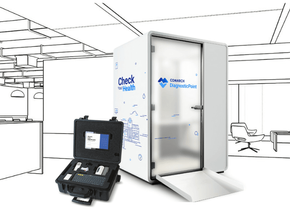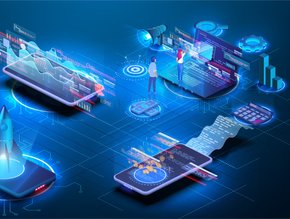Jump-starting the hyperautomation journey

A new term is accumulating quite a bit of buzz in the world of automation.
It’s so big that Gartner called it the most important of the top 10 strategic technology trends for 2020. The term is “hyperautomation,” and you might be wondering if it’s really worth all the hype.
The short answer is, “Yes. Absolutely.”
Gartner defines hyperautomation as “the application of advanced technologies, including artificial intelligence (AI) and machine learning (ML), to increasingly automate processes and augment humans. Hyperautomation extends across a range of tools that can be automated, but also refers to the sophistication of the automation (i.e., discover, analyze, design, automate, measure, monitor, reassess).”
As 2020 unfolds, digital disruption has many organizations feeling the pressure to innovate in order to streamline internal operations and customer-facing experiences more quickly. Hyperautomation delivers the speed and agility required for success.
If you want to understand hyperautomation, intelligent automation (IA) is a good place to start. An IA platform is unrivaled in its ability to hyperautomate processes, improve employee satisfaction, enhance compliance, and drive operational efficiency.
Fast track hyperautomation with Intelligent Automation
Hyperautomation requires implementing the right combination of the right technologies, in the right order, at the right time. An intelligent automation platform provides organizations with the tools needed to jumpstart digital transformation by quickly identifying and implementing AI and other advanced technologies for maximum business benefit.
An intelligent automation platform follows a methodology that catapults organizations to a state of hyperautomation via:
Process discovery: Organizations can use IA to easily analyze patterns and tasks, then quickly identify automation opportunities. Businesses can also discover potential challenges with compliance or regulatory issues and remediate them swiftly.
Digital workflow orchestration: Centrally build and run automated digital workflows in collaboration with existing applications and human workers. Orchestrating multiple people, actions, software robots, policies and systems enables organizations to analyze, measure and optimize business activities.
Robotic Process Automation (RPA): Intelligent automation takes Robotic Process Automation beyond task-based processes to support more complex and long-running workflows. Businesses can reliably and efficiently automate repetitive, manual tasks across the enterprise, even through web interfaces and business apps. Integrated “smart" automation capabilities such as cognitive capture, process orchestration and analytics allow human workers to focus on tasks requiring more critical thinking and offering more value to businesses and customers.
Artificial intelligence and machine learning: Advanced automation technologies can be leveraged to understand, classify and extract data including voice, text, chat and images. AI allows you to automatically recognize people and documents, and understand the content and context of communications. That helps organizations make more insightful business decisions. Natural language processing, entity extraction and sentiment analysis provide greater insight into customer communications across all channels. Machine learning improves the accuracy of document identification, classification and separation conducted as part of cognitive capture and RPA.
Digital workforce management: An Intelligent Automation platform provides the capability to govern a growing digital workforce, including software robots that improve security, compliance, scalability and auditability. Organizations can also increase work capacity without adding headcount. Automation of financial and regulatory processes improves transparency and compliance.
Advanced analytics: With analytics, businesses can measure the impact of intelligent automation across the enterprise and calculate ROI. Improved visibility, process intelligence and insight into customers, employees and business partners give executives the tools and information needed to adapt to changing market conditions and customer expectations.
The benefits of hyperautomation
The benefits of hyperautomation are seen throughout the entire business, positioning the organization to be recognized as an industry leader today and well into the future. Measurable advantages include:
Reduced costs: The intelligent automation of business processes and workflows reduces the time and resources needed to complete manual tasks and cuts down on the number of errors. By 2024, organizations will lower operational costs by 30% by combining hyperautomation technologies with redesigned operational processes.
Scalability: Hyperautomation transforms a manual or complex task into a highly reliable and repeatable process. A collaborative ecosystem of complementary technologies and humans working together generates exponentially better outcomes across the business.
Improved customer experience: Hyperautomation enables organizations to deliver a more personalized customer experience and respond more rapidly to customers’ questions and needs. The result is improved satisfaction, loyalty and revenue.
Operational excellence: An efficient workforce comprised of the right blend of human and digital workers creates a flexible and agile organization that can swiftly and appropriately respond to changing market conditions. Increases in productivity and the focus of human workers on higher-value tasks give businesses a competitive edge. Better compliance and transparency positions the business to promptly respond to any potential issues.
Improved employee experience: Human workers enjoy the more thought-provoking and strategic work automation allows them. Rather than performing the same tasks day after day, employees can focus on projects adding value to the organization and can spend more time improving the customer experience. Workers get more satisfaction out of their jobs when they can see the added value they bring.
Executives who want to drive innovation and transform business processes need to immerse themselves in hyperautomation. To get there fast, look for an AI-enabled intelligent automation platform with integrated capabilities, so you can work like tomorrow, today.
This article was contributed by Tyler Suss, Product Marketing Director, Kofax






